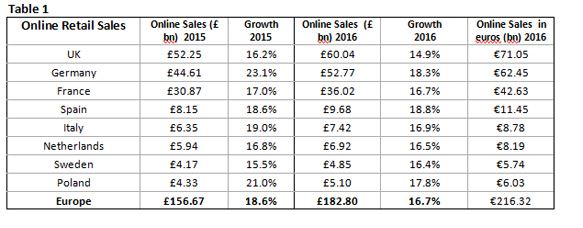The wild Atlantic has a bountiful supply for David to farm. Seaweed has eight times as much magnesium as spinach and Europeans are on a serious health buzz. The possibilities are endless, he thought.
He imagined the people of Italy lapping up his Seaweed Spaghetti, a healthy alternative to pasta, but ‘it’s just not realistic,’ he told himself.
Is David’s appetizing algae destined to enrich only the diets of his domestic buyers, or can he build his seaweed empire on foreign shores?
For online sellers like David, limiting sales to domestic markets just doesn’t make financial sense.
Europe is still an untapped market. Sellers can flourish across EU borders because demand is high and cross-border selling is now much easier.
Cross-border demand
30 percent of all online sales in Europe are now cross-border. Purchases from sellers based outside the EU have risen from 13 percent to 18 percent since 2012.
Only 12 percent of EU retailers sell online to consumers in other EU countries, according to Eurostat, the stats office of the European Union.
Eurostat pinpoint why, saying ‘the main reason the EU is currently lagging behind the US on exploiting the growth potential of eCommerce is the insufficient development of cross-border eCommerce.’
Strong demand is being met by a small number of EU retailers and increasingly from outside. So why aren’t more EU-based sellers expanding to neighbouring markets?
Accustomed to selling domestically, through well defined channels like Amazon, eBay and retail websites, many sellers perceive that selling in other territories is too risky or even impossible.
The data tells a different story.
Euro Online Shopping Facts:
- Europe has 508 million consumers
- 65 percent of internet users shop online
- Online sales grew 18.6 percent last year
The big three (UK, Germany and France) dominate with an 81.5 percent share of the market worth €176 billion. Spain (18.8%) has the highest online sales growth rate, followed by Germany (18.3%) and Poland (17.8%). As shown below, immature markets in the Netherlands, Sweden and Italy are seeing significant growth.
Top 8 EU Countries for Online Sales.
Ecommerce Europe’s Cross-Border Barometer Survey found the three main obstacles for EU-based merchants are:
- Legal fragmentation – inconsistent frameworks that inhibit trading
- Tax systems – lack of harmony in VAT rates between countries
- Logistics – distribution is still expensive and slow
PayPal’s new Cross-Border eCommerce Survey shows that shipping cost is the key reason why foreign shoppers abandon purchases in online shopping carts. Uncertainty over local taxes and delivery times are the other reasons customers fail to convert.
Related: eCommerce Translation Tools Help You Sell Internationally
Tearing down regulatory walls?
Lawmakers in Brussels are listening and do seem intent on developing a better pan-European e-Commerce regime. EU Single Digital Market legislation, currently making its way through the European Commission, will attempt to unify a 28 country patchwork of markets to give buyers better access to online goods and sellers more legal certainty.
By removing the burden of selling across borders, the EU wants to create a friendlier online selling environment to rival the US and Asia. When the legislation passes, it’s anticipated that EU online consumption will be boosted by €18 billion.
A raft of measures are being considered which could make high-quality delivery services more affordable. The proposals are designed to improve price transparency and tackle low rates of buyer trust with a single market for parcel delivery.
The opportunity to grab new customers and scale your business through cross-border markets is enormous. Seize the opportunity now or like David, risk an uncertain future.









